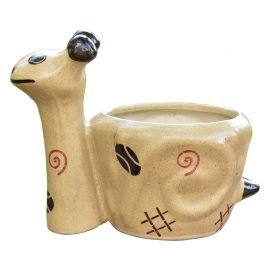Rat Tail Cacti Plants – Aporocactus Flagelliformis Cactus
₹350.00
Rat Tail Cacti Plants – Aporocactus Flagelliformis Cactus is suitable for indoor and outdoor gardens, greenhouse and tabletop gardens, and container gardening. It is known as Rat tail cactus because of its long trailing stems, thus it is apt for hanging pots or baskets.
- Indoor & Outdoor
- East to grow
- Ornamental plant
- Fast-growing
- Evergreen
- Plant height: 5-10 cm
Pack: Plant with 7 cm Black round Plastic Pot (Pot colour may vary)
Rat Tail Cacti Plants – Aporocactus Flagelliformis Cactus are very easy to grow. It is suitable for indoor and outdoor garden, greenhouse and tabletop container gardening. It is a fast-growing succulent plant so it should be repotted every other year after flowering. The green cylindrical stems dotted with clusters of small spines. It is known as Rat tail cactus because of its long trailing stems, thus it is apt for hanging pots or baskets.
Scientific name: Aporocactus flagelliformis
Common Name: Rat Tail Cactus, Whip Cactus.
Origin: Mexico and parts of Central America
Family: Cactaceae
Benefit: Ornamental Plant.
Rat Tail Cacti Plants Care
Aporocactus Flagelliformis Cactus is a hardy type that will survive worse conditions than below suggested but may not grow and flower as well. Re-pot every other year when it becomes pot bound. But don’t use a larger pot. Remember the spines can be prickly so you may want to wear protective gloves while re-potting. In the winter, old or discoloured stems may be cut out at the base to encourage new growth. Rattail plants are drought-tolerant and can tolerate long periods with little care.
- light: Prefer bright, but indirect sunlight year-round.
- Soil: Use a rich potting mix used for cactus. The best humus consists of four parts sandy loam, and one part of equal quantities of sand and crushed brick. R
- Water: To keep the soil slightly moist during summer, water it frequently and less in winter. Water when soil is dry to the touch, which is approximately every 7 – 10 days. Allow the water to flow through the drainage holes and remove the water from the pot tray.
- Temperature: Average 10 °C to 24 °C is ideal. It needs minimum 6°C to survive, so avoid below 5°C. Keep it out of frost.
- Fertilizer: Feed with a diluted liquid fertilizer or water-soluble fertilizer about half strength once every two weeks during the growing season in spring and summer.
- Propagation: By seeds and stem cuttings in summer. Let them dry for a few days to heal the wounds.
- Bloom: It flowers in spring and early summer. Usually Violet-Red, some times Pink and Orange
| Weight | 250 g |
|---|---|
| Dimensions | 15 × 15 × 30 cm |
| color | Green |
Be the first to review “Rat Tail Cacti Plants – Aporocactus Flagelliformis Cactus” Cancel reply
You must be logged in to post a review.
This site uses Akismet to reduce spam. Learn how your comment data is processed.























Reviews
There are no reviews yet.